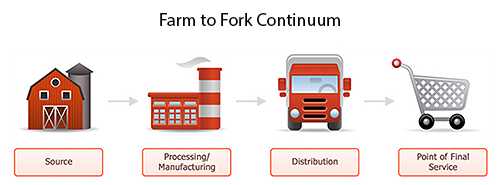Environmental Assessment Definitions
Explore this page to review technical definitions related to environmental assessments of outbreak investigations. Unless otherwise noted, definitions are adapted from Selman CA, Guzewich JJ. Public health measures: environmental assessment in outbreak investigations. [PDF – 732 KB] In: Motariemi Y, editor. Encyclopedia of food safety. 1st ed. Waltham, MA: Academic Press; 2014. p. 98-106.
Contributing Factors – Determinants that directly or indirectly cause an outbreak. A contributing factor can be biological, behavioral, or attitudinal; or an element of the physical or social environment; or the result of policies related to the problem. Contributing factors are what happened to cause a foodborne outbreak. Examples include the following:
- Retort, pasteurization, or cooking temperatures that do not destroy or reduce pathogens.
- Poor personal hygiene of food workers.
- Cross-contamination.
Environment – Everything external to the host, including air, food, water, animals, plants, climate, etc., as well as people and the social and built environments. Examples of the environment in the context of foodborne illness outbreak include
- behaviors such as hand washing by food workers,
- restaurant kitchen design, and
- the inherent characteristics of food (for example, acidity, pH, and other factors that can affect survival and growth of pathogens).
Environmental Antecedents – Supporting factors for the contamination, survival, or increase of biological or chemical agents in food. Antecedents are the reason why the contributing factors occur. They are sometimes referred to as root causes of foodborne outbreaks. They may be related to
- people,
- equipment,
- food process,
- food type,
- economics, or
- other circumstances.
Environmental Assessment (of a foodborne illness outbreak) – The systems-based component of a foodborne illness outbreak response that fully describes how the environment contributed to the introduction and/or transmission of agents that cause illness or could cause illness.
Farm-to-Fork Continuum – The system of how food flows from its source through processing or manufacturing, distribution, and finally to the point of final service, which may be a retail establishment such as a restaurant or a consumer’s home (Figure). Each stage also has its own food safety system (illustrated in the graphic below by the circles underneath each stage).

Figure. Farm-to-Fork Continuum
Foodborne Illness Outbreak – An incident in which two or more persons experience a similar illness resulting from the ingestion of a common food. (Available from: Guide to Confirming an Etiology in Foodborne Disease Outbreak.)
Food Safety System – Everything along the farm-to-fork continuum is part of the food safety system; each stage in the continuum also represents its own food safety system. Although the systems themselves are unique, they all consist of the same components:
- Inputs: items that enter the system (for example, ingredients).
- Processes, steps, and methods: to which the inputs are subjected (for example, serving, assembling, holding food).
- Internal system variables: factors that exert positive, negative, and neutral effects on all other aspects of the system.
- Outputs: immediate results of the system.
- Outcomes: what happens as a result of the outputs.
- Feedback: to that particular system on the basis of the outcomes.
Interventions (science-based) – Actions taken based on science-based recommendations from environmental assessments and other components of the outbreak investigation to halt the outbreak and prevent future ones. Immediate steps taken might include
- destroying food or taking steps to stop its distribution,
- excluding food workers who are ill, or
- closing the facility.
Longer term strategies might include
- Developing and implementing of a Hazard Analysis Critical Control Point (HACCP) plan or
- Updating and implementing policies for identifying and managing food workers who are ill with such symptoms as diarrhea, vomiting, and/or fever.
- Page last reviewed: November 6, 2015
- Page last updated: August 25, 2017
- Content source:


 ShareCompartir
ShareCompartir